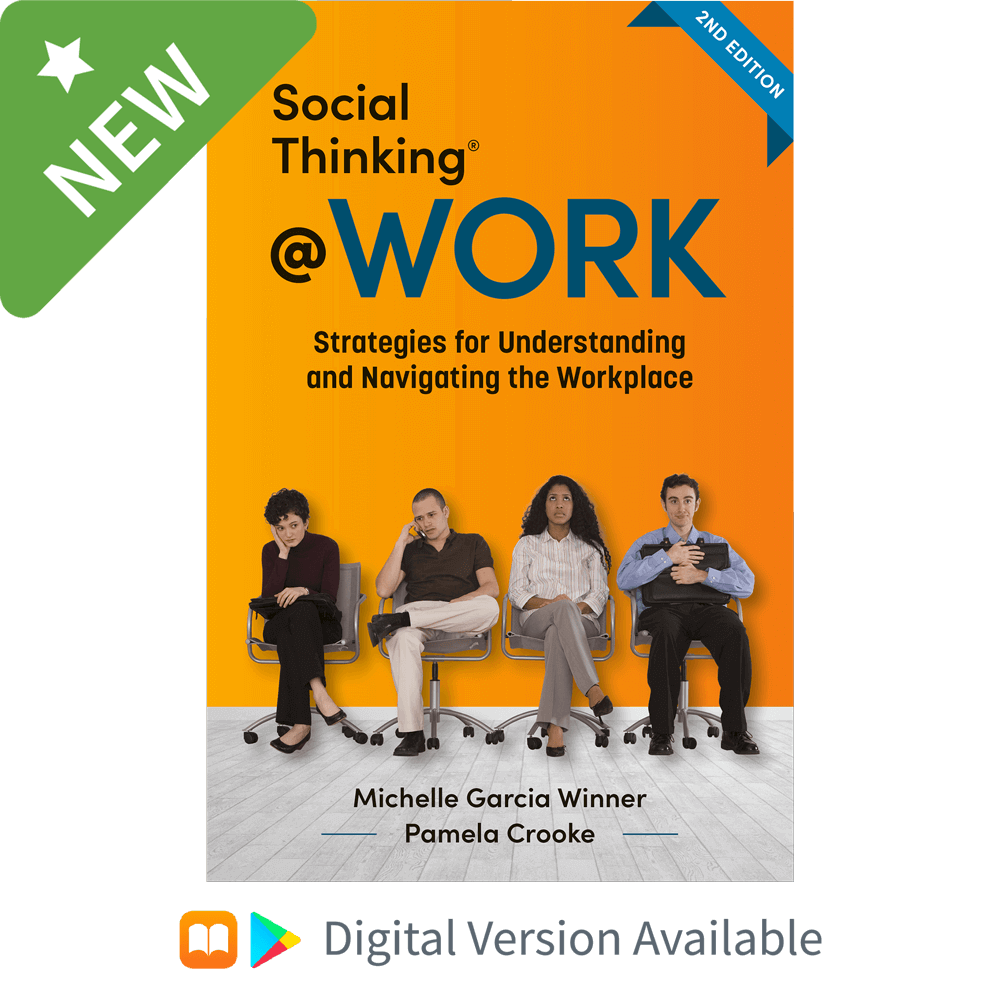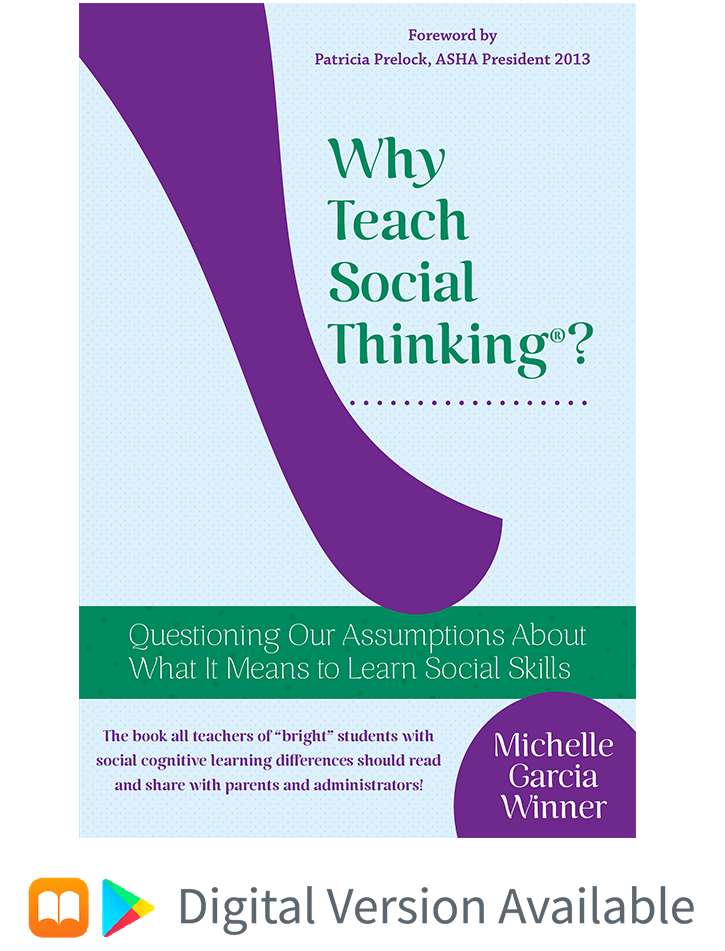© 2022 Think Social Publishing, Inc.
Neurodiversity is important. Navigating the social world is important, too. We believe both are important, have value, and are worthy of a deeper discussion.
First, we all need to be on the same page in the ways in which we define each. Neurodiversity, in most cases, refers to the idea that differences in human brain function should be recognized and respected. So, individuals who may have a diagnosis of, for example, attention deficit hyperactivity disorder (ADHD) or autism spectrum, do not have a disorder but instead learn differently. In other words, brain and learning differences are just that—brain and learning differences. Proponents would argue that these differences in learning styles result from differences in brain wiring, and that all learning styles are acceptable and should be respected as such.
Neurodiversity and multiple intelligences
The Neurodiversity movement is complementary to the principles of multiple intelligences (MI). MI proposes a broader view of intelligence as multi-dimensional, rather than a limited view of intelligence based on standardized IQ testing (Gardner, 1983). Gardner proposed varying types of intelligences which became a catalyst for a wider recognition of several types of intelligences. He noted that an athlete or artist can have intelligence that doesn’t show up on standardized testing but is equally important to nurture. He also proposed that by understanding a person’s profile of intelligences, we can identify strength-based channels, which might encourage learning in a manner that may not be as accessible through a weaker channel. Many schools today have adopted the principles of MI as they consider differing types of learners.
Few would argue that children come to school with a wide range of innate abilities in their mathematical, linguistic, spatial/artistic, naturalistic, and athletic intelligences. And our role, as parents and educators, is to help them grow, improve, and expand to the best of their abilities based on their individual starting points. We still teach math to children, even though some may be wired with stronger mathematical abilities. We don’t question why we teach history and science in the curriculum, but what about interpersonal and intrapersonal instruction (two types of intelligences that have been shown to be among the most critical for adult success)? In fact, social emotional competencies are integral to working in a group, understanding perspectives in reading fiction, writing for different audiences, and interacting with others. In some ways, inter/intrapersonal intelligence intersects and touches every part of the home and school day.
To take this example a little further, we are all clearly diverse in our bodily-kinesthetic and visual-spatial intelligences. Some of us are neurologically gifted in our coordination and creativity, while others of us must work to just do the basics. After all, most of us are not “wired” to be super athletes or artists, nor do we have the capacity or desire to do so. The reality is that we spend much of our lives honing and improving the motor and visual-spatial skills beyond the level at which we were born. Why? Because being part of humanity requires us to coexist in a world that requires us to (for the most part) feed ourselves, navigate through space without plowing into others, step over objects, balance, retrieve objects, etc. We don’t just magically achieve these milestones; we have to practice and mature with time. Some of us, with goal-oriented practice, will become high school, college, or weekend athletes, or will pursue arts/sciences careers that expand and tap into spatial abilities. As we improve, we compare the progress to ourselves—our own baseline—and not to the most gifted among us. In this manner, we grow our skills, abilities, and intelligences based on our interests, goals, and home/school requirements.
Social emotional intelligence and the Social Thinking® Methodology
We can also say with confidence that humans possess a range of innate abilities related to social and emotional intelligences. A large number of the population have okay or solid abilities, yet some are gifted, while others have challenges, similar to the spectrum found in other intelligences. This is where the Social Thinking Methodology (STM) intersects with social and emotional intelligences. The STM focuses on teaching how the social world works and how to navigate to regulate in the social world. The Social Thinking Methodology is a repository of research- and evidence-based treatment frameworks, concepts, and strategies to help all people (both neurotypical and Neurodivergent) understand the great abstractions of the social world to better function within it. Our focus is to help people develop social competencies to achieve their self-determined social goals, and gains are compared to one's own baseline learning abilities. Do we assume incompetence first? No! We learn about the person, listen to their social desires and goals, and craft our supports to tap into their strengths for learning what might be harder for them to learn. We are honest about brain differences, learning strengths, and possible hurdles. For example:
- When an adult comes to our clinic seeking help in understanding the unstated social nuances of business meetings, we begin from a place of understanding the individual’s starting place and then teach about the social world in a business landscape—how do meetings operate, who are the people present, and what is each person’s role? What is the goal of the meeting? We don’t attempt to fix, but rather expand their social emotional knowledge to empower that person to meet their self-determined goal. This might include supporting social competencies to advocate for oneself in meetings or advocate for oneself to leave meetings. This might include understanding the hidden expectations of asking for a raise or asking for a transfer. These are all considered social competencies to meet one’s self-determined social goals.
- When a child wants to be with others but is struggling to understand how to work in a group, we start from a place of teaching from their perspective about how groups work, and how they think or feel about others’ actions in groups, from their perspective first. Individuals also learn, if they are socially aware, how they may be thinking and feeling about how people perceive them. During these discussions we begin to learn what information we can provide to help them understand aspects of the social world their brain may not be picking up on intuitively. We aren’t curing anything because there is nothing to cure or fix, but we are supporting their learning by teaching how the social world works to help them advance toward developing further competencies to meet their social goal(s), such as getting into groups and then feeling included that group.
- When a teen desires but is unable to carry on a conversation with peers, we don’t impose a conversational script but rather break down the conversational act into four parts so that the abstract nature of conversations is more concrete. We are not fixing or curing them, we are simply building their metacognitive social and emotional bandwidth and practice use of specific strategies to help the teen feel they have tools for conversing with others. After all, this was their goal, and it’s our job to help them achieve it, which also helps to fend off anxiety and other mental health challenges.
These examples are not only important—but real. There is also a theme: individuals, with or without a diagnosis, have a need, sometimes a stated social goal, but don’t currently feel they have the social competencies to achieve that goal. We are not assuming incompetence; we are respecting their desire to build from their own starting place. Consider that being social is not a solo activity; it requires some level of group think and awareness of social norms within specific social landscapes (contexts), awareness of our own and others’ perceptions, and awareness of how we want to be perceived (social goals). This means that we, the therapist and the individual, need to collectively figure out where to start. Not every learner has the same starting place! Making that assumption is a bit like throwing a strategy dart at a bullseye with a blindfold on. Instead, the focus is to learn about the person first, then teach, expand knowledge, practice, imagine, understand, and reflect based on who this person is and what they want for themselves – their social desires or goal. Again, the focus is never to cure or fix because there is nothing to cure or fix. The person is not broken. This has never been, nor will it ever be, part of the Social Thinking Methodology.
But some might say that the examples above are forcing conformity to a neurotypcial standard. That giving any type of social strategy is to devalue who the person is. We see it differently. As educators and therapists, we see our roles as builders and supporters of inter/intrapersonal intelligences, more like a computer science teacher whose goal it is to build logical-mathematical intelligence. Not all students will become coders, but why wouldn’t we give them the core foundational math and logic tools? From our perspective, teaching how the social world works to navigate to regulate in it, is a way of providing the basic social tools to build upon a person’s baseline. For example, one visual teaching framework is called the Social Emotional Chain Reaction (SECR). Simply put: based on a specific social landscape and the implied or stated social norms within it, what each of us does or says in the presence of others can impact how we are perceived by others, which may impact how we are treated, which impacts how we are likely to feel about people in that situation, as well as ourselves. The SECR is just humanity and is something we all experience, no matter where we live in the world. The SECR is not about behavior control, although poor teaching may use it in that way. The SECR is to be used as a way to expose the social code that may not be clear to all types of learners. When there is an understanding that we all have thoughts and feelings about what others do and say, we are better suited to advocate for our own needs.
Expectations and the Social Emotional Chain Reaction in the social world
We all have expectations for how others behave. We have known many Neurodivergent individuals with strong logical-mathematical abilities who also struggle to understand social concepts and are judgmental in how they think and feel about others’ actions, just like neurotypicals. And in the same manner that neurotypicals do, they act and react based on their own thoughts/feelings and social perceptions and judgments. The SECR is a universal phenomenon, regardless of social emotional learning differences. If you think about it, you are probably experiencing the SECR as you read this article: what we do or say (e.g., write this article), affects how you think/feel (positive or negative thoughts and emotions) which leads you to act/react (send us an email with your thoughts) which, depending on the content of the email, has an impact on how we think and feel (e.g., pleased/affirmed or frustrated/annoyed).
This ability to notice and monitor the active and shifting perspective-taking loops when sharing space or interacting with one another is hard work for all of us, which is why there are so many counselors and therapists—for neurotypicals. There is no doubt that learning about perspective-taking loops can be more difficult for a person whose brain does not make learning social and emotional information easy. Yet, building social knowledge can be the conduit for meeting one’s own goals of being included in the work world, advancing in academics, volunteering, and/or joining friendship groups. If you think about it, not providing social emotional learning strategies and tools is, in a way, to deprive those individuals of supports that might allow them to meet their social goals. Note: Neurotypicals do not get a pass on this. They too must engage in their own perspective taking loop to think from the Neurodivergent perspective. Ultimately the point of social and emotional learning for all is to support one’s self-determined social desires/goals as well as mental health for well-being.
Why does this matter?
An individual recently asked, “So I have a goal of getting a job at ABC company and I have the technical skills to do the job, why won’t they just hire me for who I am? I don’t care about the social fluff. I know I’m better than most in coding, so why pretend the social stuff matters to me?”
We would argue that most of us, neurotypical and neurodiverse, do not have the option to pass on the societal and communal requirements or expectations of work, home, school, or community environments. Currently, American Disabilities Act (ADA) law does not protect a person if they don’t do their due diligence to attempt to learn the social expectations for that work setting based on their own unique social learning abilities. We didn’t make the laws, but we certainly aren’t going to refuse to help a Neurodivergent person who seeks support. We’ve worked with numerous individuals who have lost jobs, relationships, and educational opportunities—not because of willful acts—but rather due to learning differences that left them with gaps in social knowledge. All jobs require us to fill in our own knowledge gaps, whether math-based, logic-based, or socially based. And, schools, homes, restaurants, online groups, gaming events, job interviews, dating, and group work, to name just a few, all require some level of social understanding, even if the understanding means that the social landscape requires one to not interact or just be quiet. Whether or not we agree with how a business or classroom, or store is operated, we still have to figure out how to get our needs met (our goals) in that context with that group of people.
Respecting each person’s unique social goals
So, how did we help this individual meet his goal of getting this job? We took a deep dive into how the social world works in businesses like ABC. We explored his learning style and the ways in which his brain worked to perceive the social world. We looked at expectations of the work environment and studied how his expectations aligned with the company. We explored how the SECR works both ways in interviews. We discussed which parts of the social world he thought he needed to attend to and which he didn’t. We did research into other fields that didn’t require him to have to consider others’ perspectives (we found none in his interest set), and we broke the social world into micro-segments to analyze and decipher it. Armed with social knowledge in the form of increased social awareness, he then practiced increasingly refined social responses. His social goal was to get a job, and his logical-mathematical, spatial-musical intelligences provided the necessary criteria to make that happen, but that was not sufficient. His dream career involved other people and, therefore, some level of social knowledge, as well as socially based adaptations on his part. He did not change “who he was.” Instead, he reported that he was given information that his brain did not naturally absorb. He learned core social information about how to interpret, problem solve, and adapt his behavior and manage his anxieties in a manner that helped him to achieve his goal. He didn’t hide who he was, nor did he feel like he was “masking” or compromising his true identity. In this case, he had a self-determined social goal, gained the tools he needed to meet his social (work) goal, and then “adapted” his social behaviors to meet this goal. The distinction here is adapting to meet one’s own social goal vs. masking to meet another’s demand. Note: While not the case here, we do understand that some people have reported being forced to “mask” their identity (gender, sexuality, diagnosis) in order to get, keep or maintain their job. The mental health impact can be extremely detrimental.
Our role as teachers and clinicians is to recognize when a person expresses a social goal and then support the learning to progress towards that goal. Sometimes the goal is to get a job, sometimes it’s to make and keep a friend, and sometimes the goal is to gain strategies to self-regulate in tough situations or advance to a leadership role. There are endless types of social goals and all involve understanding how the social world works.
We know this is just one example, but we have worked with many, many Neurodivergent persons over the course of 30+ years. And many have clear ideas about their own personal social goals but are unsure of how to progress toward meeting them. This is where we would provide social emotional learning strategies and frameworks to fill in social knowledge. In this process, we’ve learned to avoid assumptions about the depth of what a person understands, regardless of their language and cognitive strengths. For example, an engineer (PhD) whose goal was to relate to more people at work expressed great frustration as to why a coworker, with whom he’s attended many meetings, asked him if his name was “Preston” as they stood together in a line in the cafeteria. Preston stated with great frustration, “I know he knows my name, so why would he ask me?” The interaction was causing him extreme anxiety and confusion. By giving Preston knowledge about how the social world works—that he might infer that the intention of the coworker was just to informally introduce himself and chat while standing in line—helped Preston decrease his angst and anxiety. It’s also an example of the SECR playing out in real time: Preston had thoughts, feelings, judgments, and reactions to another person’s actions.
Intervention gone wrong
The Social Thinking Methodology provides concepts, visual teaching frameworks, strategies, and tools for social learners, both neurotypical and Neurodivergent. But some components of the methodology are not a match for all types of learners, and to use this work as a blanket social intervention is to use it incorrectly. Those who benefit from components of the STM are those who can “think about thinking” (metacognition) and “talk about thoughts and language” (regardless of the mode: verbal language, AAC, sign language, etc.). Unfortunately, some have been reported to implement components of the Social Thinking Methodology in a behavioral, punitive, or corrective manner, bypassing the intentions of the goals of the individual, as a fast track to enforce compliance or how to “behave” based on the goals of the adult, teacher, or therapist. No part of the methodology is ever intended for this kind of application. Instead, the focus should be on how individuals learn, their unique brain differences, their own social goals, and ways to meet those goals. Teaching should be proactive, slow, deep, and authentic.
We know we can’t control what people do with our work, but we continue to share and clarify with articles, updates to printed products, online trainings, and other media. While regrettable, there will always be trolls, ill-informed, critics, and those who take comments or clips out of context or use outdated material to make a point. We admittedly have made mistakes in how we’ve written or talked about our work in the past, but we have learned and evolved throughout the past 25 years. Those who dip into Internet archives, retrieve old publications, and dig up outdated PowerPoints to find material that does not reflect the evolution of the Social Thinking Methodology, will no doubt find fodder to perpetually criticize. Instead, we urge you to focus on the fact that we continue to learn and evolve in our thinking based on the latest research, our work with both Neurodivergent and neurotypical learners and their families, and our clinical expertise. It is our mission to continue this evolution toward informed and effective understanding and practice, just as all of us are expected to socially evolve over the course of our lives.
The Big Picture
12 tenets of the Social Thinking® credo
- Neurodiversity is important. Understanding the social world is also important. We value both. For us, they are not mutually exclusive because we respect the brain and learning differences of all people. We also understand that some believe that social skills should never be taught. This is unfair to Neurodivergents and neurotypicals who seek help in meeting their social goals. We will not turn them away.
- The Social Thinking Methodology has never promoted and will never promote fixing or curing people. We don’t believe there is anything to cure or fix. We work alongside and with people to increase their social competencies to meet their self-determined goals—socially and emotionally. Their gains can only be compared to themselves, not neurotypical standards.
- The Social Thinking Methodology demands respectful language and actions toward Neurodivergent and neurotypical individuals. There is no room for name-calling, punishing, shaming, or punitive teaching.
- Using strategies to meet one’s social goals does not mean changing that person into something they are not. As humans, we all flex and adapt as we interpret the social norms within a social landscape by using strategies that help us meet our own social goals.
- Both Neurodivergents and neurotypicals have social expectations and reactions to the language and behaviors of others in context, and this process is called the social emotional chain reaction.
- Strategies and tools from the Social Thinking Methodology are not for everyone. The work is designed for sophisticated language users with solid cognitive abilities. Both neurotypical and Neurodivergent individuals can learn from the concepts.
- Like any approach, methodology, curriculum, or program available to all types of learners: if it is not helpful, then it’s not a good fit. If teaching social strategies goes against your value system, then don’t use our work, but please be respectful of those who chose to do so.
- The Social Thinking Methodology is grounded in social cognition and social metacognition. Components of the methodology should never be altered to be delivered in an ABA-like fashion, behavioral, or any other “training”-type intervention. Specifically, Superflex and the Team of Unthinkables (we are officially changing Unthinkables to UnthinkaBots over the course of 2021-24) and Thinkables should never be used to force compliance or as a means for behavior control. None of the work should be taught using external rewards.
- Neurodiverse individuals and their families have, over the past 25 years, been contributors to all of our books, games, and resources. They help to develop, critique, test, and refine what we put out to the larger community. They will continue to be key players in its ongoing evolution.
- We all have different learning strengths and challenges and types of intelligences.
- Building strategies and tools to meet whatever social goals we might set for ourselves based on our strengths, differences, and challenges is a good thing.
- Learning about how the social world works in order to navigate to regulate in it is the overarching goal of the methodology as a way to help people meet their own self-determined social goals.
Rethinking Autism Assessment, Diagnosis, and Intervention Within a Neurodevelopmental Pathway Framework
The Social Thinking Methodology was recently highlighted in a peer-reviewed article for taking explicit steps to reflect awareness of and support for neurodiversity affirming ways. Click here to read more.
References and resources:
Gardner, H. (1983). Frames of mind: The theory of multiple intelligences. Basic Books.
Neurodiversity: What You Need to Know
Stanford Neurodiversity Project















